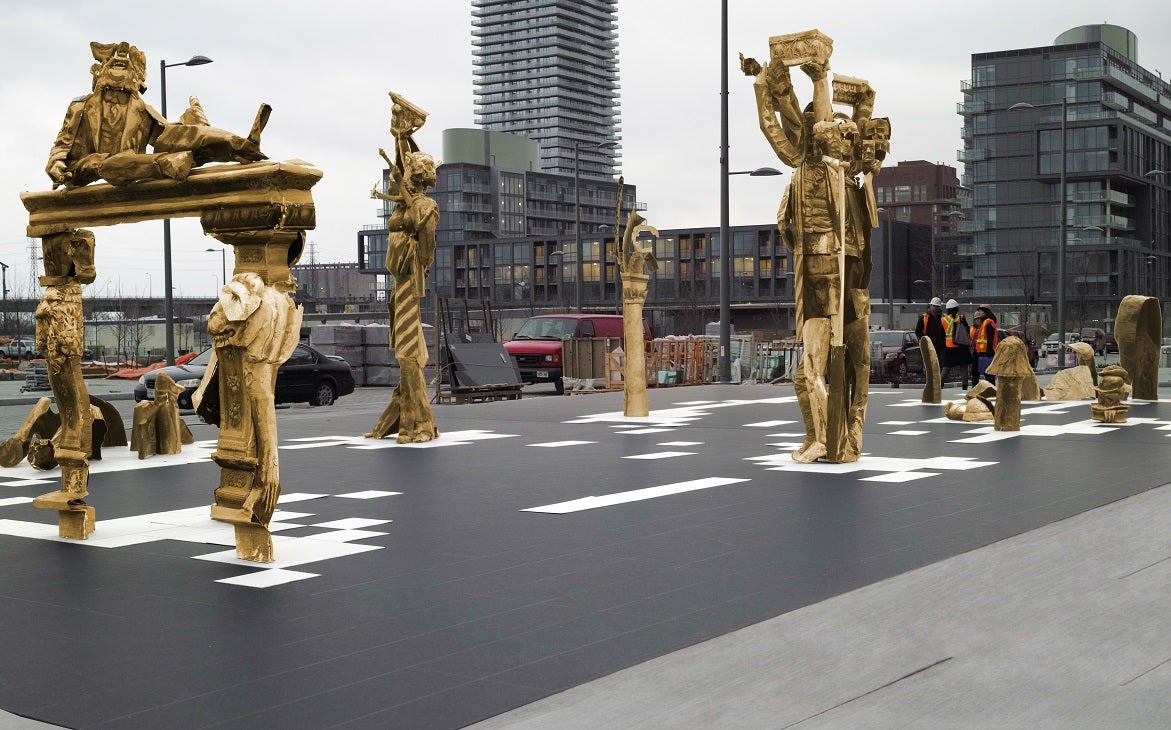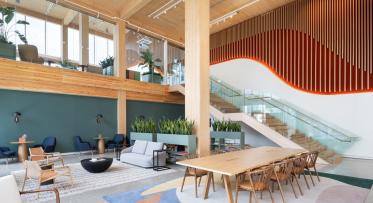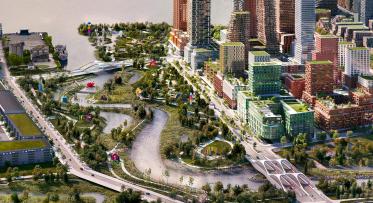A Virtual Tour of New Public Art in the West Don Lands
Check out the new public art that has been installed in Toronto's West Don Lands neighbourhood!
POSTED: JULY 13, 2015 I DESIGN, PARKS AND PUBLIC SPACES, PUBLIC ART
BY: REBECCA CARBIN
The Waterfront Toronto art program is attracting serious talent. Commissions by high-calibre Canadian and international artists are drawing attention and showcasing the benefits of big-picture art planning. Last year we posted a blog about our public art program and provided a preview of the works being commissioned within the West Don Lands neighbourhood.
Today, the artworks comprising Phase 1 of the ambitious West Don Lands Public Art Strategy are complete (or very near completion). While the public may not be able to encounter most of them in person until the site opens to the public in spring 2016, we couldn’t resist showing them to you now. There are currently six new artworks in the neighbourhood, with another on the way.
We are thrilled with the program so far and want to introduce you to your new neighbours:
The Water Guardians, by Jennifer Marman and Daniel Borins with James Khamsi
When Marc Mayer took up the role of Director of the National Gallery of Canada, he noted Marman and Borins as “young artists to watch”. Well, I had already been watching and working with them and I have had the privilege of working with them again in realizing this project for the West Don Lands. The challenge with this site was to create a work that would engage children. The Water Guardians [LINK] thoughtfully integrates art, landscape and play in a concept that is both serious and whimsical. With bouncy ground plane, variegated topography and graphic form and colour, the artwork’s aesthetic speaks readily to children in a playful way. But the title and watchful eyes denote a more serious regard for children, who need guardians, but are also guardians of the future. The artwork acts as a bridge between the nearby man-made water feature and the real Don River that flows beyond the end of Front Street, while the absence of actual water hints at a natural resource to be protected and appreciated.
Untitled (Toronto Lamp Posts), by Tadashi Kawamata
Tadashi Kawamata is based in Paris and internationally celebrated, but is no stranger to Toronto. He has shown a couple of grand scale temporary pieces here over the years – you may have seen Garden Tower [LINK] as part of Nuit Blanche in 2013, or you may even remember his installation at Colonial Tavern Park on Yonge Street opposite the Eaton Centre, Toronto Project 1989 [LINK], commissioned by Mercer Union – but this is his first permanent commission in Toronto and it was a thrill to be part of his unique way of working to realize this piece. Toronto Lamp Posts on Front Street creates an iconic visual landmark for this area. The work applies the artist’s international art practice in a concept that is unique to Toronto and the industrial heritage of the West Don Lands area. Over the decades and across the map, Toronto’s city of neighbourhoods, has donned lamp posts in a wide variety of styles, materials and heights that have come to characterize eras and areas. To make this piece, a selection of lamp posts was sourced from various yards and depots and the artist worked in an organic way, selecting on the spot which post would go where, to create the effect he intended. The result is wonderful: having the appearance of Mikado sticks [LINK] just before they fall, the formal bundling together of this jumble of city infrastructure collapses history and geography into one playful gesture.
Peeled Pavement, by Jill Anholt
Peeled Pavement was developed by Vancouver-based artist Jill Anholt, through collaboration with the Planning Partnership as an integrated feature of the public realm design for Mill Street. Installed along Mill Street which connects the Distillery District to Corktown Common, Peeled Pavement punctuates the sidewalk with a series of tears in the urban fabric, curling up to reveal an underside of industrial artifacts cast in bronze and, in their absence, swathes of glowing light, the energies of the working city. Exposing the layers and systems of the site, the piece links history to the renewal of life in the present and growth envisioned for the public realm of the future.
No Shoes, by Mark di Suvero
Mark di Suvero is internationally considered to be one of the most significant sculptors of the 20th century and we are so thrilled to include an important early work of his in our West Don Lands program. In 1967, while in the early stages of his career, di Suvero was invited by the City of Toronto to participate in an International Sculpture Symposium in High Park. Di Suvero was given access to a crane and operator and the results were two monumental pieces, Flower Power and No Shoes [LINK], which were the first works in what became the artist’s signature style. The title and appearance of effortless symmetry are expressions of the optimism of the 1960s. This optimism resonates with the revitalization and future neighbourhood, while the materials of the sculpture speak to the natural and industrial history of the area. After a lengthy restoration and re-installation coordinated with the City of Toronto, who continues to own the work, and overseen by di Suvero himself, No Shoes was installed in Corktown Common in 2013, the same year that di Suvero was awarded the prestigious Gold Medal from the American Academy of Arts and Letters.
Site Specific, by Scott Eunson and Marianne Lovink
If you‘ve been by the intersection of Sumach and Eastern recently, you’ve likely noticed that it looks dramatically different now than it did a year ago! We’ve just finished installing an artwork by Toronto- and Philidelphia–based artist team Scott Eunson and Marianne Lovink. Site Specific, uses the 40 metre long linear site to portray, in abstract pattern and form, a deep history of human existence in the immediate area, with an expanded focus on the era of Thornton and Lucie Blackburn whose home was on the site of the adjacent Inglenook Secondary School. The artists worked with historian Karolyn Smart Frost and the students of the school in the making of the artwork and a related student exhibition, currently on show at Tandem Café around the corner on King Street East. Site Specific brings visual poetry about the human stories that make a place; it is the latest, very exciting chapter in a historical narrative whose telling completely transforms the place.
Mirage, by Paul Raff
Unveiled in 2012 in Underpass Park, Mirage, by Toronto-based artist Paul Raff, blurs the horizon lines between earth and sky with the artist using the unusual site conditions of a park under an elevated roadway as conceptual and formal frame. The installation of 57 octagonal mirror polished stainless steel surfaces applied to the underside of the Richmond/Adelaide overpass draws inspiration from the definition of a mirage as an optical illusion created by atmospheric conditions. Each of the panels is slightly different in size and spacing to create a subtle sense of movement as their mirror-polished surfaces bounce light around the space.

Garden of Future Follies, by Hadley+Maxwell (currently in fabrication and to be installed in the spring of 2016)
With substantial international exhibition history under their belt, artist duo Hadley + Maxwell (Hadley Howes and Maxwell Stephens) are making their first permanent public artwork, and it is going to anchor a key social space in the new neighbourhood. Garden of Future Follies will bring the past to life by fragmenting and rearranging parts of monuments, sculptures and architecture from all over the City of Toronto. Based on the idea of the folly – a fanciful and purely decorative structure popular in 18th and 19th century romantic gardens and landscapes– this project reimagines a ‘garden of follies’ incorporating elements from monuments that are normally high above the street and physically out of reach, bringing them down to street level where they can be celebrated and enjoyed. The work will build a collection of unusual characters that creates a sense of play, inviting us to explore and interact with our city’s history.
This is a bold project and it is thrilling to be part of their realization as the process is completely unique. The sculptures will be created using a “cinefoil” process, which uses a thick aluminum foil material pressed against an object to take its shape. The aluminum impression is then used to create a mold and cast a bronze version of the original. For the artists, this means an opportunity to re-envision how parts of an existing work can create a completely new sculpture; these fragments are then reassembled by the artists to form a new and imaginative cast of characters, named for archetypes found within the tradition of monument. With this new public art work, Hadley and Maxwell are tackling the idea of the monument and asking us to question the way we think about public art.
About the West Don Lands Public Art Strategy
Waterfront Toronto is committed to commissioning contemporary art works that are publicly accessible and part of everyday life in our new neighborhoods. Our goal is to create a cohesive program that meaningfully integrates artwork into the streets and public spaces of our waterfront, by pooling funds from our development partners and creating a collection for each waterfront neighborhood that highlights the character of the place and creates exceptional opportunities for public engagement and encounter.
The West Don Lands is the first Waterfront Toronto neighbourhood to integrate public art in the early planning phases. As Waterfront Toronto designed the public realm – streets, overpasses, parks and other public spaces – public art was considered from the start, rather than added as an afterthought. At the end of this first phase, the results of this big picture thinking are obvious: meaningful opportunities for artists result in meaningful artwork for the public. The artists engaged big ideas and big effort and the results are tremendous. To the first artists of Waterfront Toronto’s art program, on behalf of Torontonians and our visitors, a BIG THANK YOU!



